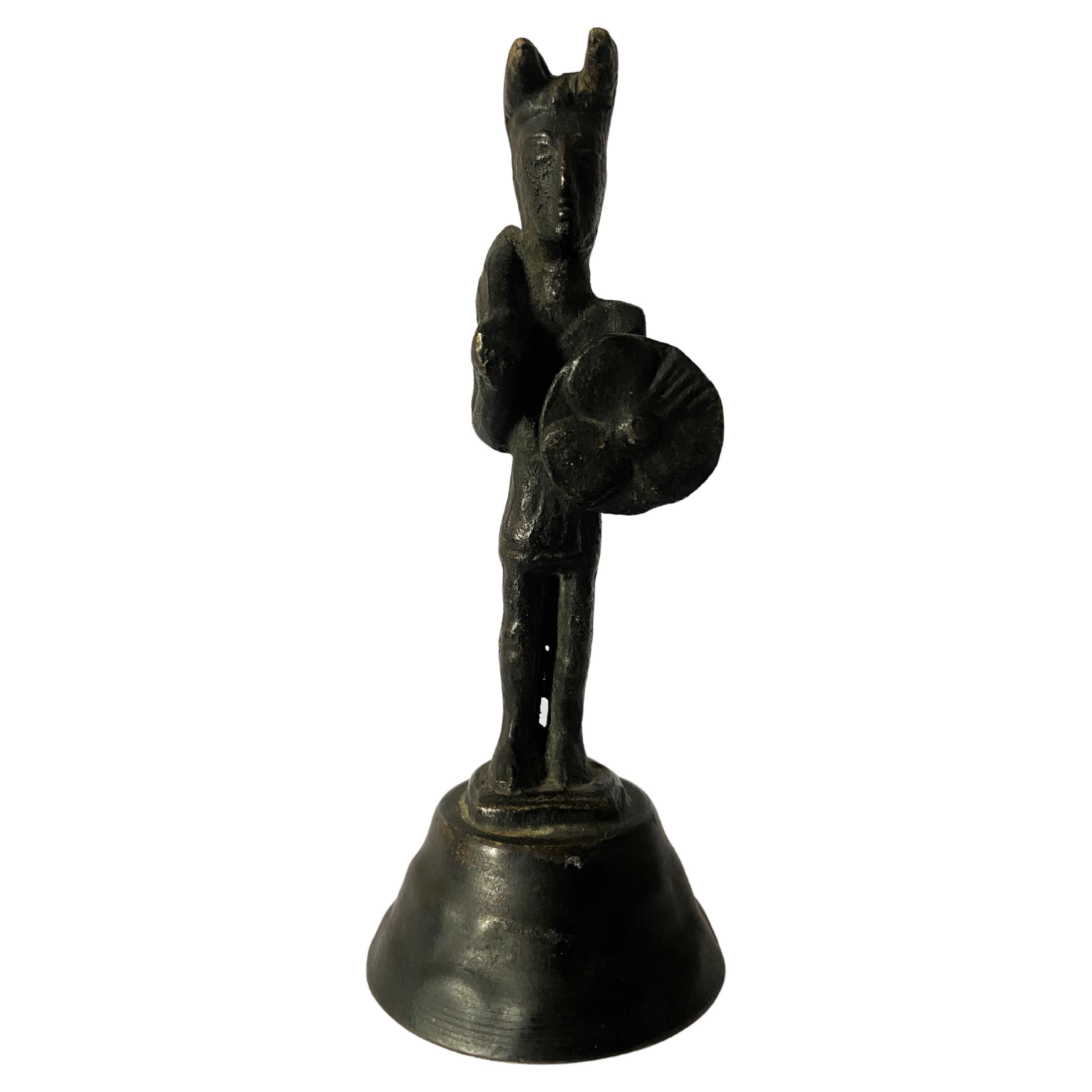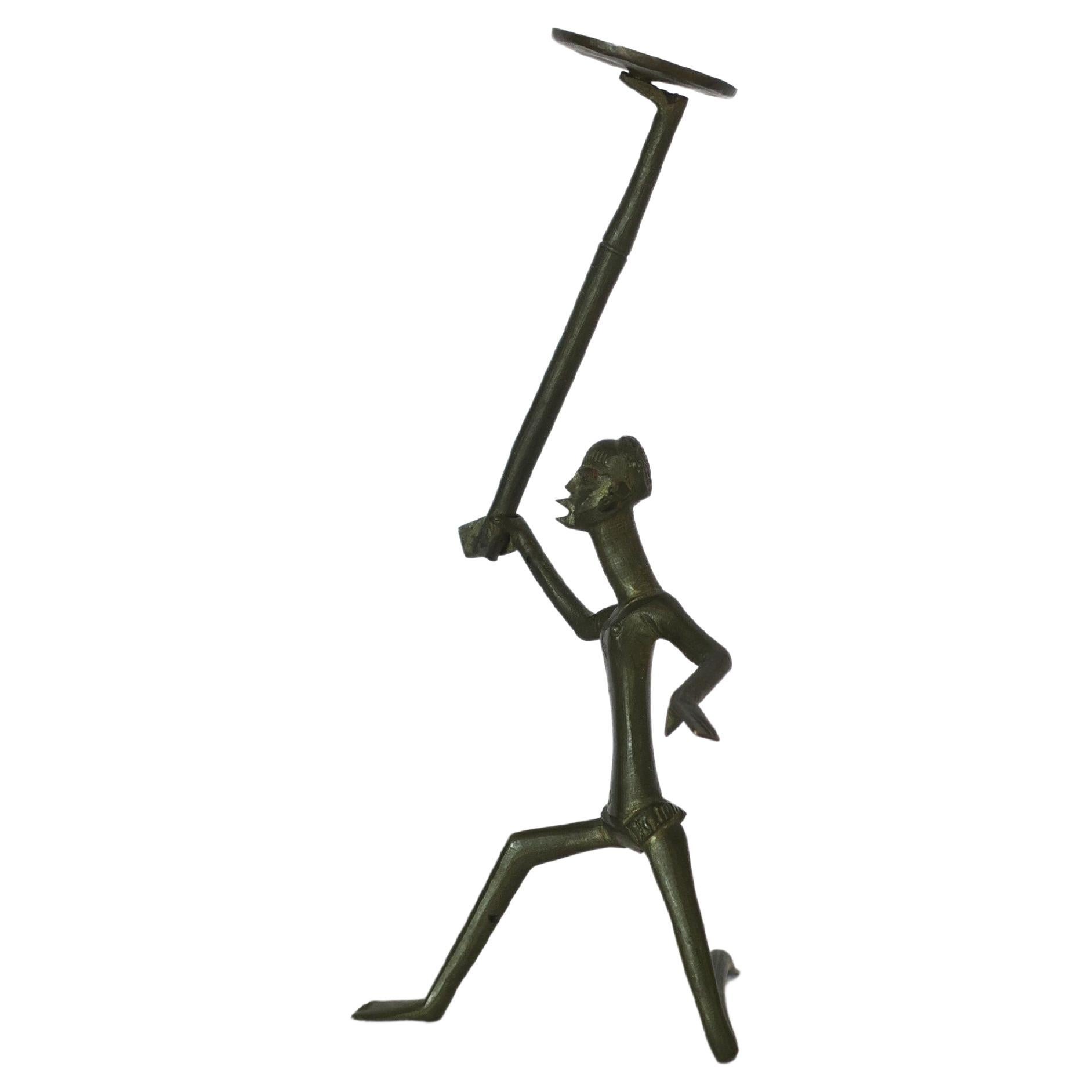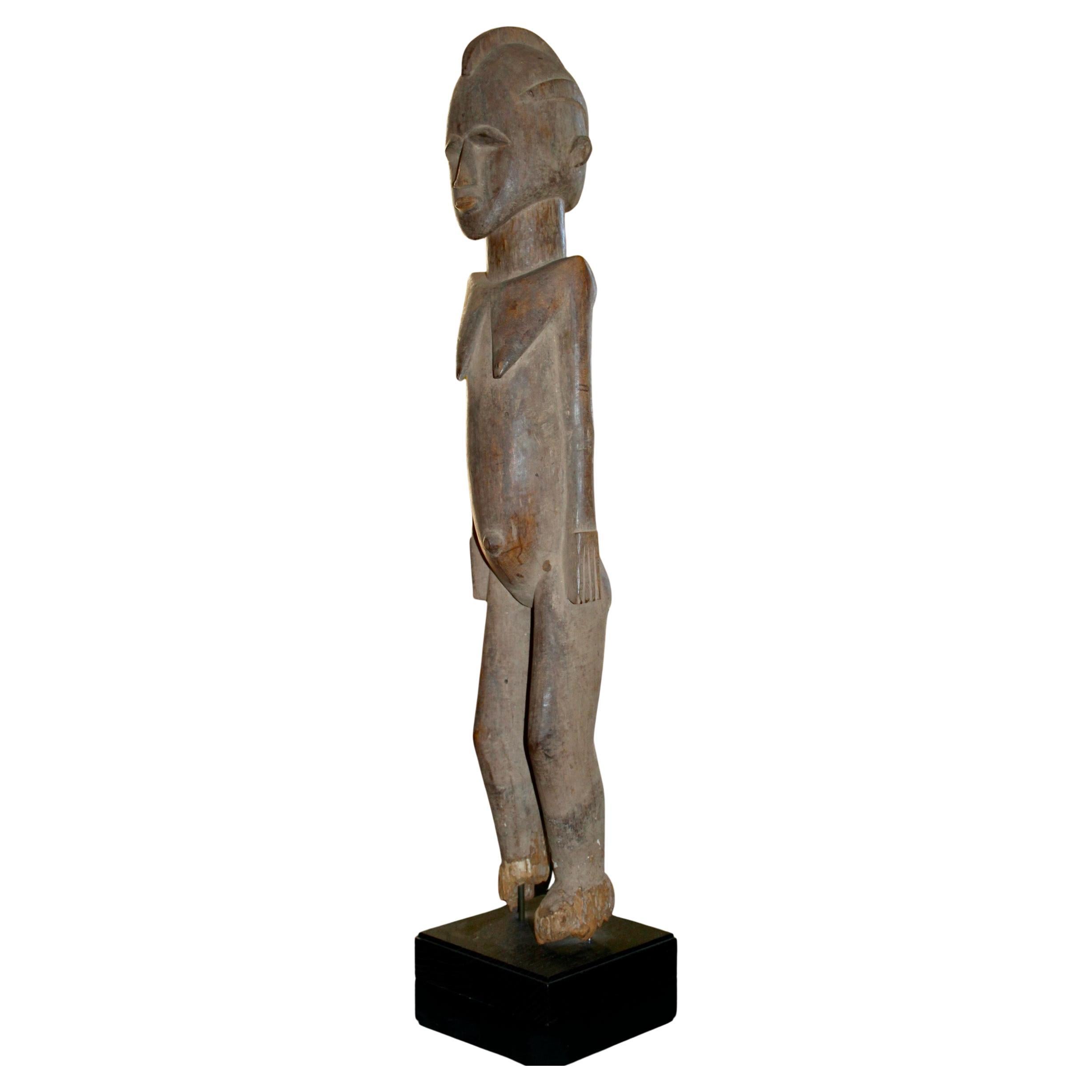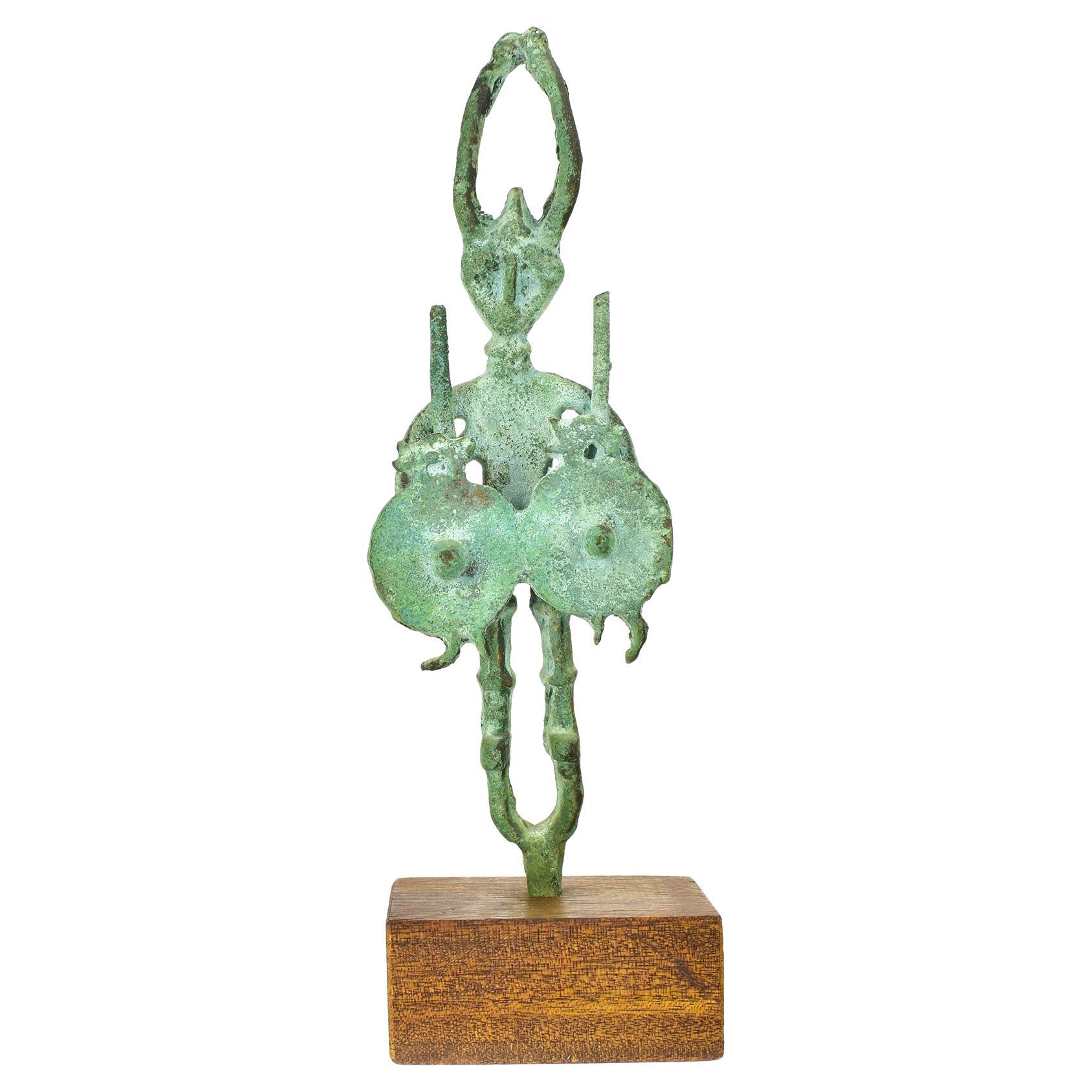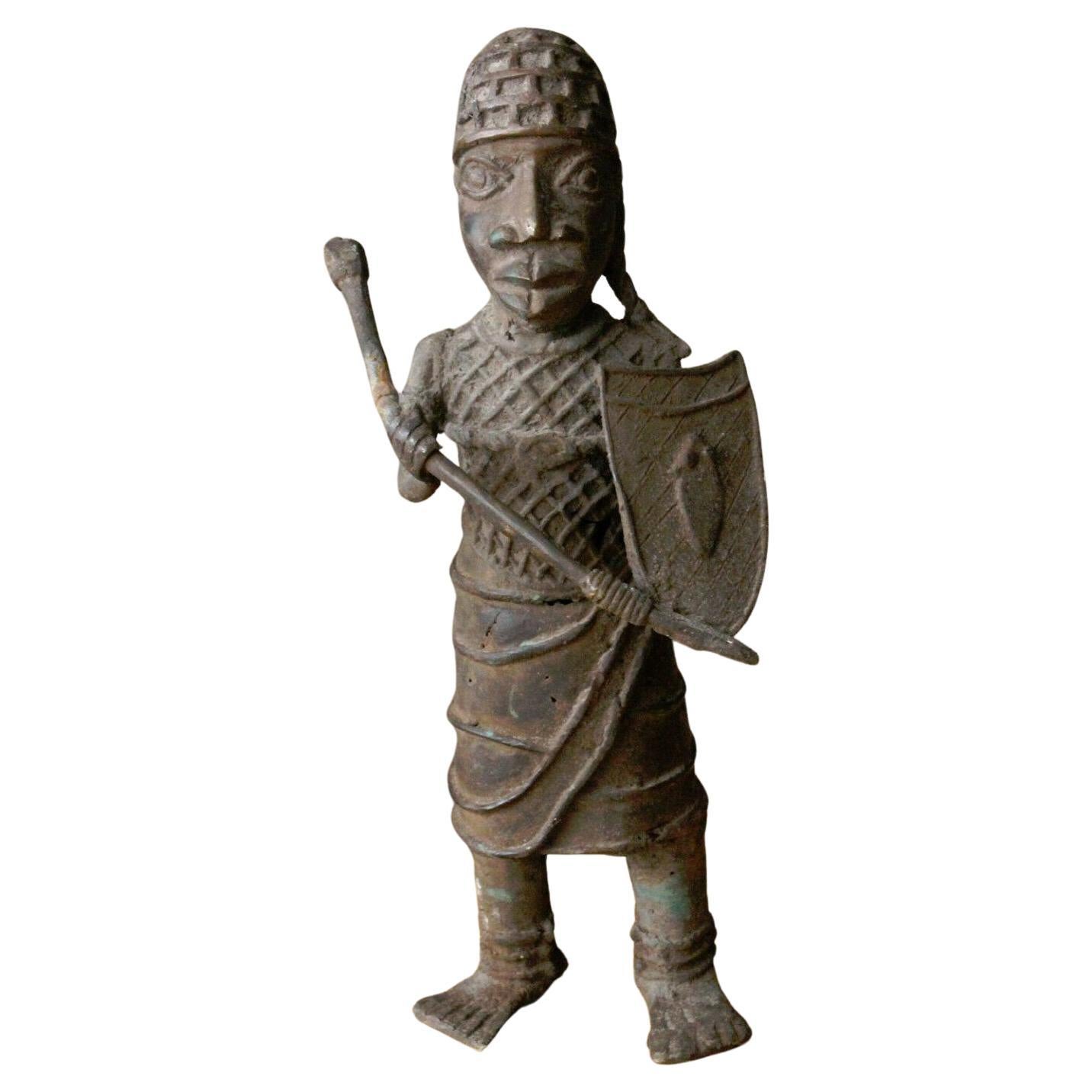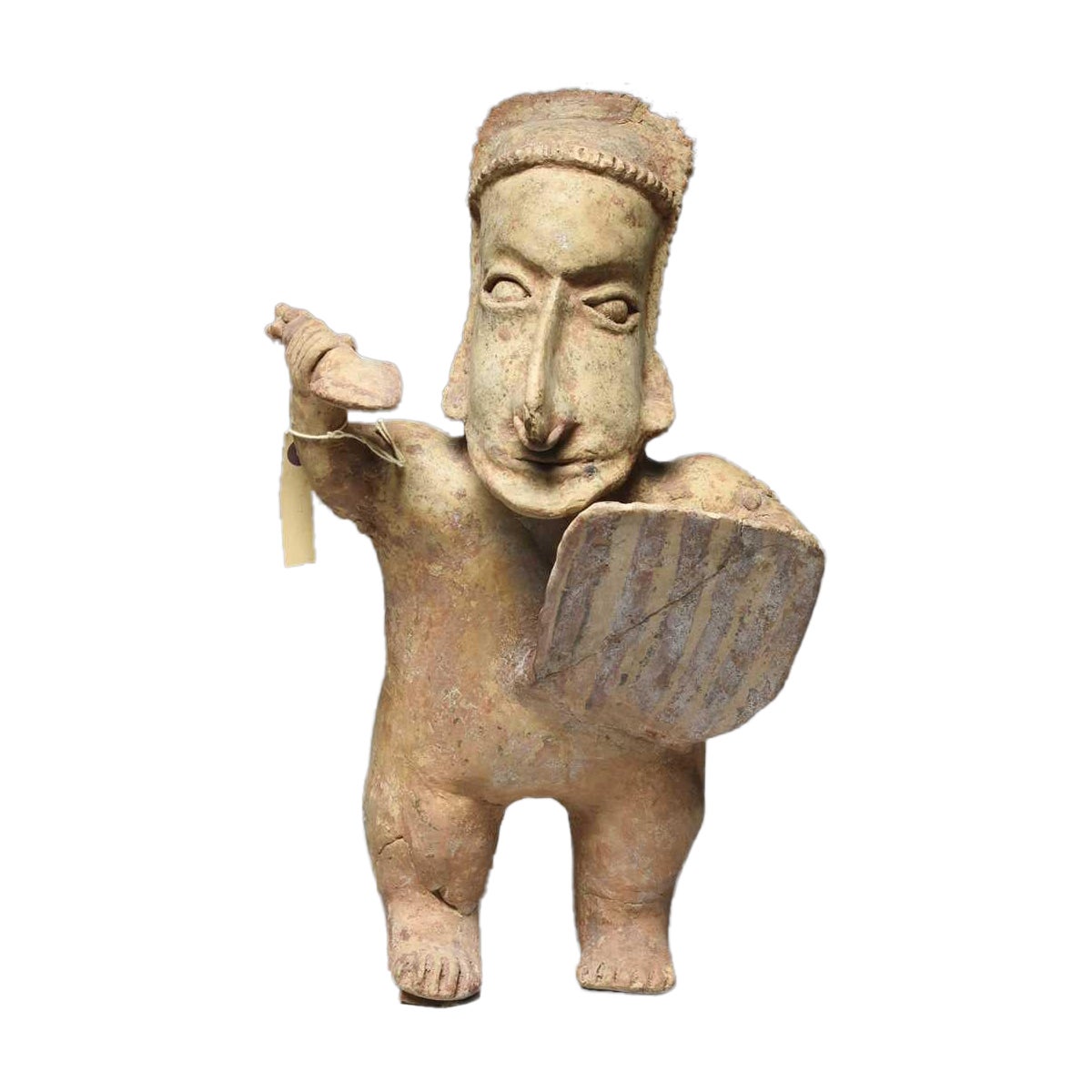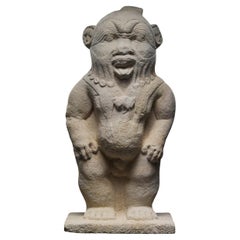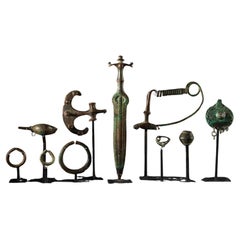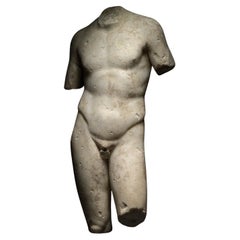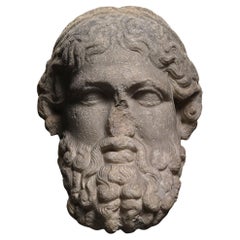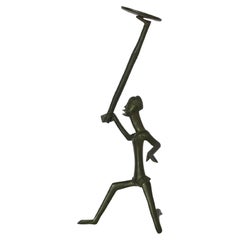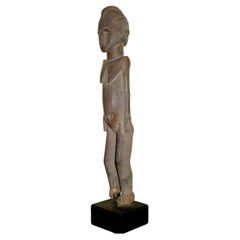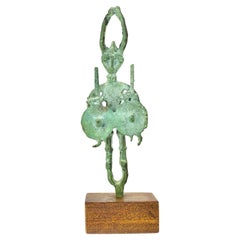Items Similar to A Sardinian Figure of a Warrior
Want more images or videos?
Request additional images or videos from the seller
1 of 8
A Sardinian Figure of a Warrior
$187,649.06
£137,000
€161,027.85
CA$259,074.85
A$287,222.78
CHF 150,946.78
MX$3,515,135.75
NOK 1,885,171.76
SEK 1,769,422.32
DKK 1,201,972.89
About the Item
An exceptionally rare and important Sardinian bronze figure of a warrior. The highly stylized figure is depicted standing, holding a club resting on his shoulder in the right hand and a round shield with central boss in the left. The warrior wears leggings under a short kilt, a cuirass, ringed neck-guard, and crested helmet with fragmentary horns. The statue was produced in the Nouragian (from ‘nuraghe’, the type of ancient Bronze Age building found across the island), or Geometric, period of Sardinian art. This is one of very few of its type outside Sardinia.
Different types of Nuragic statuettes depicting human figures have been identified: the ‘tribal leaders’, the shepherds, the warriors, the archers, the worshipper(s), groups (mother and child, wrestlers, etc.). These are recognised as representing the higher classes of a hierarchical social structure – those with religious, political or militaristic responsibilities. This figure is of the warrior type. The statuette likely had a votive function; many similar figures have been discovered in the famous Nuragic sacred wells of the island.
Accompanied by a detailed condition report, inventory notes from the Albright-Knox Art Gallery, and a chemical analysis report carried out by Arthur Beale in 1975 when he was Acting Chief Conservator of the Fogg Art Museum, in preparation for the inclusion of the bronze in a publication by Dr. Miriam S. Balmuth (‘Sardinian Bronzetti in American Museums’, Studi Sardi (1975-1977), Vol. 24).
Exhibited
Contemporary Art: Acquisitions 1962-1965, Albright-Knox Art Gallery, Buffalo, New York, 30 September – 30 October 1966.
¿Kid Stuff?, Albright-Knox Art Gallery, Buffalo, New York, 25 July – 6 September 1971.
Kunst und Kultur Sardiniens: vom Neolithikum bis zum Ende d. Nuraghenzeit, Badisches Landesmuseum Karlsruhe, 18 April -13 July 1980, then Museum für Vor- u. Frühgeschichte d. Staatlichen Museen Preussischer Kulturbesitz Berlin in Berlin-Charlottenburg, 31 July – 14 September 1980.
Published
Art Quarterly, vol. 29. no. 1, 1966, p. 71.
Contemporary Art: Acquisitions 1962-1965, Albright-Knox Art Gallery, Buffalo, New York, 30 September – 30 October 1966, pp. 28, 84.
Stephen A. Nash, with Katy Kline, Charlotta Kotik, and Emese Wood, Painting and Sculpture from Antiquity to 1942, Albright-Knox Art Gallery, New York, 1969, p.73, illus.
Charlotte B. Johnson, Color and Shape, A-KAG, 1971, illus., pp. 11-12.
Kunst und Kultur Sardiniens: vom Neolithikum bis zum Ende d. Nuraghenzeit, Badisches Landesmuseum Karlsruhe im Karlsruher Schloss vom 18. Apr.-13. Juli 1980, Museum für Vor- u. Frühgeschichte d. Staatlichen Museen Preussischer Kulturbesitz Berlin in Berlin-Charlottenburg vom 31. Juli-14. Sept. 1980, no. 104.
Miriam S. Balmuth, ‘Sardinian Bronzetti in American Museums’, Studi Sardi (1975-1977), Vol. 24, 145-52, passim, figs. 1 and 2.
Provenance
Previously in a Private Collection, Germany, from at least 1960.
With Jacques O. Matossian (1893-1963), Egypt, acquired from the above, until 1960.
With Marguerite (1900-1977) and Paul Mallon (1884-1975), living at that time at Hotel Hassler, Rome, 1960 to 1965.
Albright-Knox Art Gallery, Buffalo, NY, USA (inv. no. 65.22), acquired from the above 30th December 1965 with the George B. and Jenny R. Mathews Fund (includes a dated acquisition record).
ALR: S00218849, with IADAA certificate, this item has been checked against the Interpol database.
- Dimensions:Height: 6.3 in (16 cm)Width: 3.15 in (8 cm)Depth: 3.15 in (8 cm)
- Materials and Techniques:
- Place of Origin:
- Period:
- Date of Manufacture:Circa 7th - 6th century B.C.
- Condition:Repaired: Cracks across proper left elbow and proper right forearm probably indicating repairs. 161. Wear consistent with age and use. Corroded as shown. Tips of horns and upper end of sword fragmentary.
- Seller Location:London, GB
- Reference Number:1stDibs: LU5517242131062
About the Seller
5.0
Vetted Professional Seller
Every seller passes strict standards for authenticity and reliability
Established in 1910
1stDibs seller since 2020
- ShippingRetrieving quote...Shipping from: London, United Kingdom
- Return Policy
Authenticity Guarantee
In the unlikely event there’s an issue with an item’s authenticity, contact us within 1 year for a full refund. DetailsMoney-Back Guarantee
If your item is not as described, is damaged in transit, or does not arrive, contact us within 7 days for a full refund. Details24-Hour Cancellation
You have a 24-hour grace period in which to reconsider your purchase, with no questions asked.Vetted Professional Sellers
Our world-class sellers must adhere to strict standards for service and quality, maintaining the integrity of our listings.Price-Match Guarantee
If you find that a seller listed the same item for a lower price elsewhere, we’ll match it.Trusted Global Delivery
Our best-in-class carrier network provides specialized shipping options worldwide, including custom delivery.More From This Seller
View AllLimestone Statue of Bes
Located in London, GB
A large freestanding statue of the ancient Egyptian god Bes in his canonical form as a stocky dwarf. His face is highly expressive, with large, teardrop-shaped eyebrows drawn into an...
Category
Antique 15th Century and Earlier Egyptian Egyptian Antiquities
Materials
Limestone
$96,563
Corsican Bronze Hoard
Located in London, GB
Dagger L: 27.8 cm,
Luniform bronze, possibly a belt buckle L: 10.8 cm,
Shield-shaped bronze with a point Diam: 6.5 cm,
Pommel Diam: 3.7 cm,
Violin-bow brooch L: 17.5 cm,
P-Shape...
Category
Antique 15th Century and Earlier European Classical Roman Antiquities
Materials
Bronze
$88,756 / set
Torso of a Youth
Located in London, GB
A marble statue of a youth in contrapposto position. The torso is idealised but has only softly suggested muscles, giving the impression of youth. The beginnings of the slender arms ...
Category
Antique 15th Century and Earlier European Antiquities
Materials
Marble
$417,598
Marble Head of Hermes
Located in London, GB
Roman head of the god Hermes in an archaising style, following a Greek model from the fourth century B.C.. Hermes is depicted in manner typically found on herms, with a full beard of...
Category
Antique 15th Century and Earlier European Classical Roman Antiquities
Materials
Marble
$69,649
Portrait Head of Emperor Marcus Aurelius
Located in London, GB
A marble portrait head of the Roman emperor Marcus Aurelius (r. 161-180 A.D.), in his fourth and final portrait type. Known as the Capitoline Imperatori 38 type, after the most famou...
Category
Antique 15th Century and Earlier European Classical Roman Antiquities
Materials
Marble
Large Mosaic Glass Dish
Located in London, GB
A shallow glass dish with a composite mosaic pattern formed from polygonal sections of yellow and green canes, set into a translucent green background.
Mosaic glass bowls, dishes, a...
Category
Antique 15th Century and Earlier European Classical Roman Antiquities
Materials
Glass
$33,621
You May Also Like
Statuette of a Nuragic Warrior 18th Century before J-C
Located in Beuzevillette, FR
Very beautiful statuette of a Nuraghic warrior dating from 18 century before J-C. The warrior rests on a hollow base. He carries in his right hand a weapon, surely a knife, and in his left hand a shield decorated with a four-petal flower. He is wearing a headdress decorated with two horns. This statuette was realized in bronze by a technique of casting of "lost wax" (a process of precision), and carries a label in the hollow base: "bronzetto nuragico guerriero" (bronze nuragic "warrior").
The Nuraghic culture makes its appearance in Sardinia, in the age of bronze...
Category
Antique 15th Century and Earlier Figurative Sculptures
Materials
Bronze
Tribal Sculpture Male Warrior Figure in the Style of Hagenauer
Located in New York, NY
A small bronze male tribal warrior figure sculpture piece, in the style of Hagenauer, Tribal style, circa 20th century. A male bronze tribal figure holdi...
Category
20th Century Tribal Figurative Sculptures
Materials
Bronze, Brass
A Lobi sculpture
Located in grand Lancy, CH
A Lobi sculpture with nice patina and nice style
Category
Antique Late 19th Century Burkinabe Tribal Art
Materials
Wood
$3,800
Nuragic Bronze Warrior Figurine Sculpture Sardinian Bronze Age Style Italy 1960s
Located in Bad Säckingen, DE
This striking bronze represents a four-armed warrior in the style of Sardinian Bronze Age figures, known as "bronzetti."
Crafted in the 1960s in Italy, the figure exudes a unique pa...
Category
Vintage 1960s Italian Brutalist Figurative Sculptures
Materials
Bronze
Monumental 19th Century Benin Oba Warrior Bronze Sculpture! Africa
By People from Benin
Located in Peoria, AZ
MAGNIFICENT!
BENIN OBA
19TH CENTURY BRONZE
WARRIOR SCULPTURE!
SUPERB EXAMPLE OF OBA METALWORK!
DIMENSIONS: APPROXIMATELY 13" TALL
CIRCA 1860-1900
Offered is a rare 19th cen...
Category
Antique Late 19th Century Beninese Tribal Figurative Sculptures
Materials
Bronze
$4,800 Sale Price
36% Off
Pre Columbian Large Jalisco Figure West Mexico Circa B.C. 100-300 A.D
Located in London, GB
A Pre Columbian Jalisco warrior figure
Jalisco West Mexico circa B.C. 100-300 A.D,
A stunning large pottery warrior figure wearing a banded headdress with disco arm ornaments , ...
Category
Antique 15th Century and Earlier Mexican Antiquities
Materials
Pottery
More Ways To Browse
Folk Religious Art
Antique Kunst
Antique Boss
S Shepherd
Antique American Folk Art Sculpture
Tribal Art Antiques
Tribal Shield
Antique Egyptian Ring
Ancient Helmet
Folk Art 1960s Wood Sculpture
German Shepherd Antique
Antique Religious Ring
Antique Mothers Ring
Gallery B R
Antique Class Ring
Warriors Rings
Antique Votive
German Helmet
